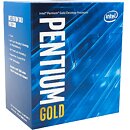Monday, October 19th 2020

Intel "Tiger Lake" Based Pentium and Celeron to Feature AVX2, an Instruction the Entry-Level Brands were Deprived Of
Intel's next-generation Pentium Gold and Celeron entry-level processors based on the "Tiger Lake" microarchitecture could finally receive the AVX2 instruction set. Intel had segmented AVX and AVX2 to be exclusive to the Core and Xeon brands, with the Pentium Gold and Celeron products based on the same microarchitectures to artificially lack these instructions.
Intel updated its ARK product information database with entries for "Tiger Lake" based Pentium Gold and Celeron products. The page for the Pentium Gold 7505 and Celeron 6305, mention support for AVX2 besides SSE4. Both are mobile chips with 15 W TDP, and are built on the same 10 nm SuperFin process as the rest of the 11th Gen Core "Tiger Lake" processor family.
Intel updated its ARK product information database with entries for "Tiger Lake" based Pentium Gold and Celeron products. The page for the Pentium Gold 7505 and Celeron 6305, mention support for AVX2 besides SSE4. Both are mobile chips with 15 W TDP, and are built on the same 10 nm SuperFin process as the rest of the 11th Gen Core "Tiger Lake" processor family.

39 Comments on Intel "Tiger Lake" Based Pentium and Celeron to Feature AVX2, an Instruction the Entry-Level Brands were Deprived Of
There were really low power M chips for netbooks/tablets that have had AVX2 for years which made no sense and yet Pentium only receive this know ? Why ? Mind boggling, it's like they do everything against any common sense.
Not surprising, though. They don't seem to have a problem using Intel TSX, which is probably even more exotic than AVX2
However, my opinion is that the firewall is inherently the weak point and not the underlying OS. No firewall is a bulletproof solution, all it gives you is more time to react against threat as it slow down the attacker. Therefore I believe IP Fire is a better solution than PFSense although both have its merits.
It's obviously used in numerous productive tools like Photoshop, Premiere, Blender, video encoders (ffmpeg etc.), CAD, etc.
But also compression (7zip, winrar), web browsers (at least for video), and even a couple of games.How come?
AMD have in some ways been better at adopting AVX2, featuring it even in their entry level products, and have supported it since Excavator(2015).
If anything, AVX-512 should be Intel's stronghold, if only they featured that across the entire lineup.AVX2 doesn't really use that much more die space than AVX, since it mostly adds some new operations and extended integer support, so there is really no reason for Intel to design an AVX-only implementation when they already have an AVX2 implementation.
Intel have been starving budget cpus of several function for years and because of that set back most PC to the digital stone age.
A simple thing like AES acceleration have been excluded for years in budget cpus for no real reason except Intels greed. Now there are tens of millions of PCs out there that are crippled when it comes to encryption and cannot smoothly accelerate VPN without tanking the computer to a stand still.
Now AMD are forcing their hand to increase performance and unlock functions on budget cpus. Intel would never have done this if there was no pressure from AMD.
I am honestly not sure if I use the benefits of AVX2 -- I always thought that AVX always referred to 1.0 but your post made me do a bit of research, and now I can't really tell if it automatically uses 2. When I had Skylake-X and had AVX-512 it was NEVER used (which was a shame) so I had lumped AVX 2.0 into that category as well.
If they are enabling SSE2 in Celerons, then maybe they will also enable it on Atom cores. That would make Tremont's successor actually look appealing !
You don't need to use it on those Clelerons, but enabling the feature will mean a lot more software devs will feel it is worth their time to develop/optimize SSE2-paths.
You don't have to have impressive performance, but universal support will open-up the door for more optimization. For example, AMD's Jagua only has 128-bit vector units, but they added AVX support. Faster can come at a later time, but making the intruction-set universal will eventually give you that "corner-case vector benchmark" optimization come to more apps.
Haswell (Pentium and Celeron didn't have it until Haswell)Sandy Bridge. We're talking AVX2 here."AVX" can be confusing, since it can refer to AVX(1) or the whole family (AVX(1), AVX2, AVX-512).
In a way you can view AVX2 as the first full 256-bit SIMD instruction set, while AVX(1) was mostly a partial 256-bit extension of SSE4, but with a new syntax. AVX2 added more operations and flexibility over AVX(1), and added full 256-bit integer support. From a software development perspective, there isn't much use in using AVX(1), since AVX2 is more flexible and complete, only at the expense of dropping support for Sandy Bridge and Ivy Bridge (SB didn't have any good AVX performance anyway). By using AVX2 you usually get the bonus feature of FMA too, which really can accelerate some algorithms.
AVX-512 is unfortunately (to my knowledge) not yet used in consumer software. This is the chicken and the egg problem, as usual. But it's important to get these features widespread so software can start to utilize it. AVX-512 will be massively powerful when we see real applications use it, there will be no going back.